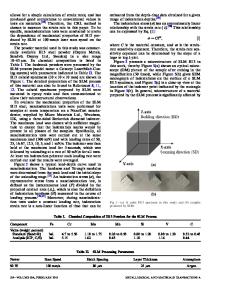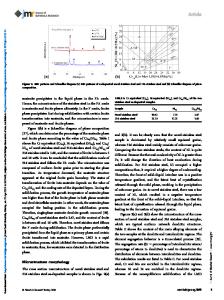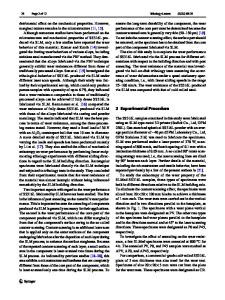Corrosion Behavior of 316L Stainless Steel Fabricated by Selective Laser Melting Under Different Scanning Speeds
- PDF / 3,997,345 Bytes
- 11 Pages / 593.972 x 792 pts Page_size
- 85 Downloads / 395 Views
ÓASM International 1059-9495/$19.00
Corrosion Behavior of 316L Stainless Steel Fabricated by Selective Laser Melting Under Different Scanning Speeds Xiaoqing Ni, Decheng Kong, Wenheng Wu, Liang Zhang, Chaofang Dong, Beibei He, Lin Lu, Kaiqi Wu, and Dexiang Zhu (Submitted December 15, 2017; in revised form March 2, 2018) This work discussed the effects of different scanning speeds (800, 1083, 1200 and 1400 mm/s) on the microstructure of 316L stainless steel manufactured by selective laser melting (SLM) and the related corrosion behavior. Results showed that there were more voids with faster scanning speeds, and there were oxide powder and non-melt silicon inside the defects. The SLM 316L exhibited a full gamma austenite phase filled with sub-grains, and the average grain size of SLM-1083 mm/s 316L was approximately 42 lm, three times larger than that of the quenched 316L. The pitting potentials for the SLM 316L were all approximately 300 mV higher than that of the quenched due to the modification of inclusions in SLM, but the corrosion rate for the SLM 316L was faster, which was attributed to the voids and unstable passive film. The number of pitting sites increased with the scanning speed, and the pits occurred preferentially at the voids in SLM 316L. Keywords
316L stainless steel, corrosion properties, electron back-scattered diffraction, selective laser melting, transmission electron microscopy
1. Introduction Selective laser melting (SLM) uses a high-intensity energy source to melt powder, followed by a rapid solidification procedure, and this method has attracted much attention in recent years (Ref 1-3). The SLM technique offers unique advantages for producing components that cannot be made by traditional manufacturing methods, including an improved material utilization ratio, high accuracy and complexity, time saving and so on. However, this rapid prototyping technique also incurs defects that are frequently observed in the microstructures of SLM-produced alloys. The mechanical properties of SLM samples vary when produced by different processes. Duan et al. (Ref 4) found that 3D-printed AerMet 100 steel was slightly worse than the commercial wrought products because of the existence of voids in the samples, and some authors (Ref 5-7) have suggested that thermal stresses and elemental segregation phenomena result
Xiaoqing Ni, Wenheng Wu, Liang Zhang, Beibei He, Lin Lu, Kaiqi Wu, and Dexiang Zhu, Shanghai Engineering Research Center of 3D Printing Materials, Shanghai Research Institute of Materials, Shanghai 200437, China; Decheng Kong and Chaofang Dong, Corrosion and Protection Center, Key Laboratory for Corrosion and Protection (MOE), University of Science and Technology Beijing, Beijing 100083, China. Contact e-mails: [email protected], [email protected], and [email protected].
Journal of Materials Engineering and Performance
from the high-temperature gradients that occur during the SLM process because of the short interaction period and the extremely high heat input. However, if the fabrication process
Data Loading...











